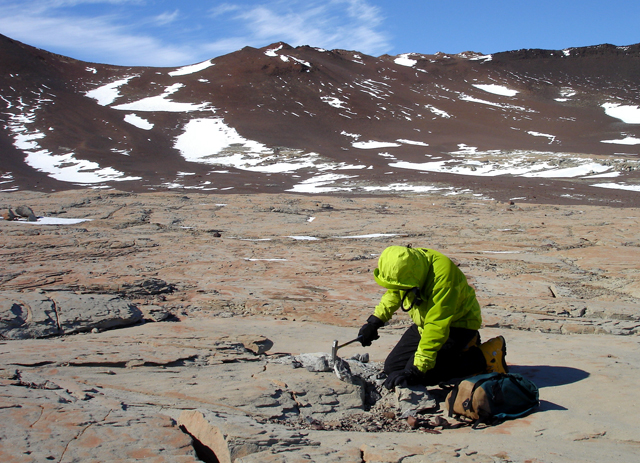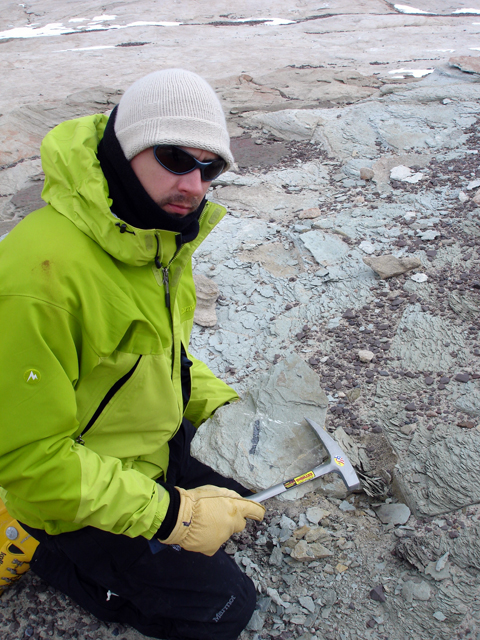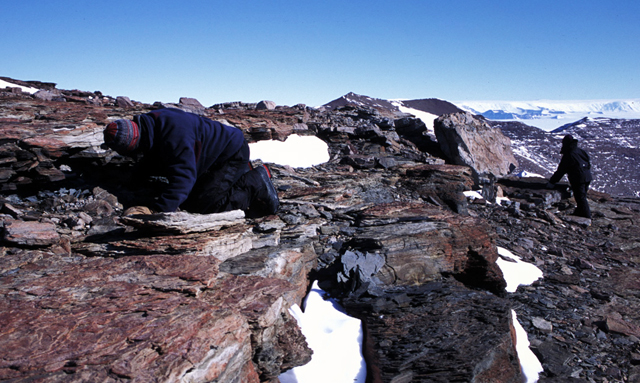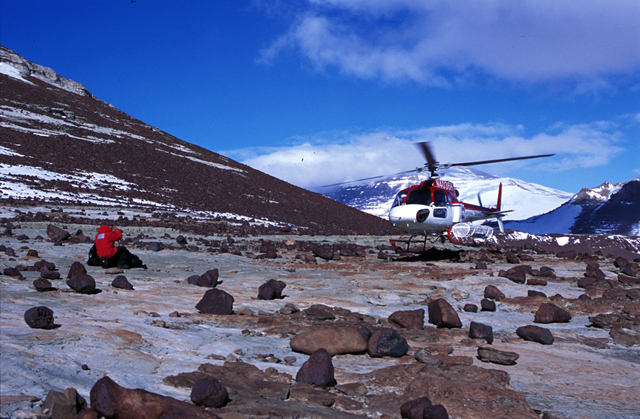Climate refugeStudy: Life retreated to Antarctica during mass extinctionPosted February 5, 2010
Life on Earth hit a particularly rough patch about 250 million years ago, when about 90 percent of marine species went extinct along with about 70 percent of land organisms, including the only large-scale extinction of insects. Apparently, there were few places to hide from disaster at the end of the Permian, a geologic period that lasted for about 50 million years until the widespread extinction of life. Several hypotheses exist on what caused the extreme destruction of life. One of the leading theories involves global warming caused by massive volcanic activity that formed the Siberian Traps in Russia. Based on that assumption, researchers in a recent paper suggest that the far south of Pangaea — present-day Antarctica — served as a climate refuge for some vertebrate species. The evidence comes from a new species discovered in the Transantarctic Mountains about 30 years ago that the paleontologists recently described in the journal Naturwissenschaften. “The climate models and the fossils are both telling us that this area was relatively habitable at this time,” said Christian Sidor Kombuisia antarctica was a four-legged animal about the size of a house cat that burrowed in the ground. It belonged to a larger group of extinct mammal relatives, called anomodonts, which were widespread and represented the dominant plant eaters of their time. Unlike mammals, it likely laid eggs, didn’t nurse its young and didn’t have fur, according to Jörg Fröbisch from The Field Museum “The new discovery fills a gap in the fossil record and contributes to a better understanding of vertebrate survival during the end-Permian mass extinction from a geographic as well as an ecological point of view,” Fröbisch said in a press release from The Field Museum, which funded his part of the study along with colleague Kenneth D. Angielczyk. Based on reconstructions of latitude, geography and climate at the time of the Permian-Triassic extinction, Kombuisia probably lived in a region of Pangaea subject to extreme swings in temperature, according to Sidor. Summer temperatures might have reached 15 to 20 degrees Celsius despite being likely located south of the Antarctic Circle. Sidor said Kombuisia appears earlier in the fossil record in Antarctica than it does in South Africa, where similar species have been discovered but in much greater abundance thanks partly to a longer history of exploration and easier access. “Fossils from Antarctica are very rare; they’re very difficult to find,” said Sidor, who has made two trips to Antarctica looking for fossils from the Triassic, a geologic period lasting from 251 to 199 million years ago that followed the Permian-Triassic extinction. “If [Kombuisia] had been present in South Africa at the same time as Antarctica, we would have found it,” Sidor said. “The fact that it appears earlier in Antarctica suggests to me and the co-authors that it’s an early appearance of this taxon” or group of vertebrates. Attempts to find older tetrapod fossils in Antarctica, into the Permian, have failed so far, according to Sidor. In 2008, he and colleagues Molly Miller and John Isbell published a paper in the Journal of Vertebrate Paleontology that described 245-million-year-old fossilized burrows — some of the first such finds in Antarctica. Sidor said it’s possible Kombuisia or a similar tetrapod could have created the burrows. “This type of burrow has been found in South Africa with Thrinaxodon bones in them,” he said, referring to another distant relative of mammals. “These animals all lived at about the same time.” There is much uncertainty about what might have inhabited the burrows because of the paucity of the fossil record, particularly in Antarctica, Sidor noted. Paleontologists have only been on the hunt for fossils on the continent since the 1970s, and the few areas of exposed rock that are of interest to scientists are hard to access and work in. One of those areas is a region of the Beardmore Glacier in the central Transantarctic Mountains. Sidor and a team of fellow scientists plan to go there for the 2010-11 summer field season to seek new fossils and recover others left behind during the last major expedition to the site in 2003. “It’s the one place you can go in the Transantarctics where the rocks go from the Permian all the way to the Jurassic. It’s got the longest terrestrial record preserved in Antarctica,” he said, a period of geologic history about 100 million years long. Sidor and his team will focus on the Triassic period, while others will pinpoint the Jurassic, the time when dinosaurs dominated. He is eager to recover an exposed fossil — a rib cage or backbone — that he found buried under about a meter of rock in 2003 but didn’t have the time or tools to retrieve. The field camp, located near the U.S. Antarctic Program’s McMurdo Station “We’re really lucky,” he said. “We hope to do a good job and find more fossils that will help us understand the history of Antarctica.” NSF-funded research in this story: Christian Sidor, University of Washington, Award Nos. 0838762, 0551163 and 0440910 |



For USAP Participants |
For The Public |
For Researchers and EducatorsContact UsNational Science FoundationOffice of Polar Programs Geosciences Directorate 2415 Eisenhower Avenue, Suite W7100 Alexandria, VA 22314 Sign up for the NSF Office of Polar Programs newsletter and events. Feedback Form |





